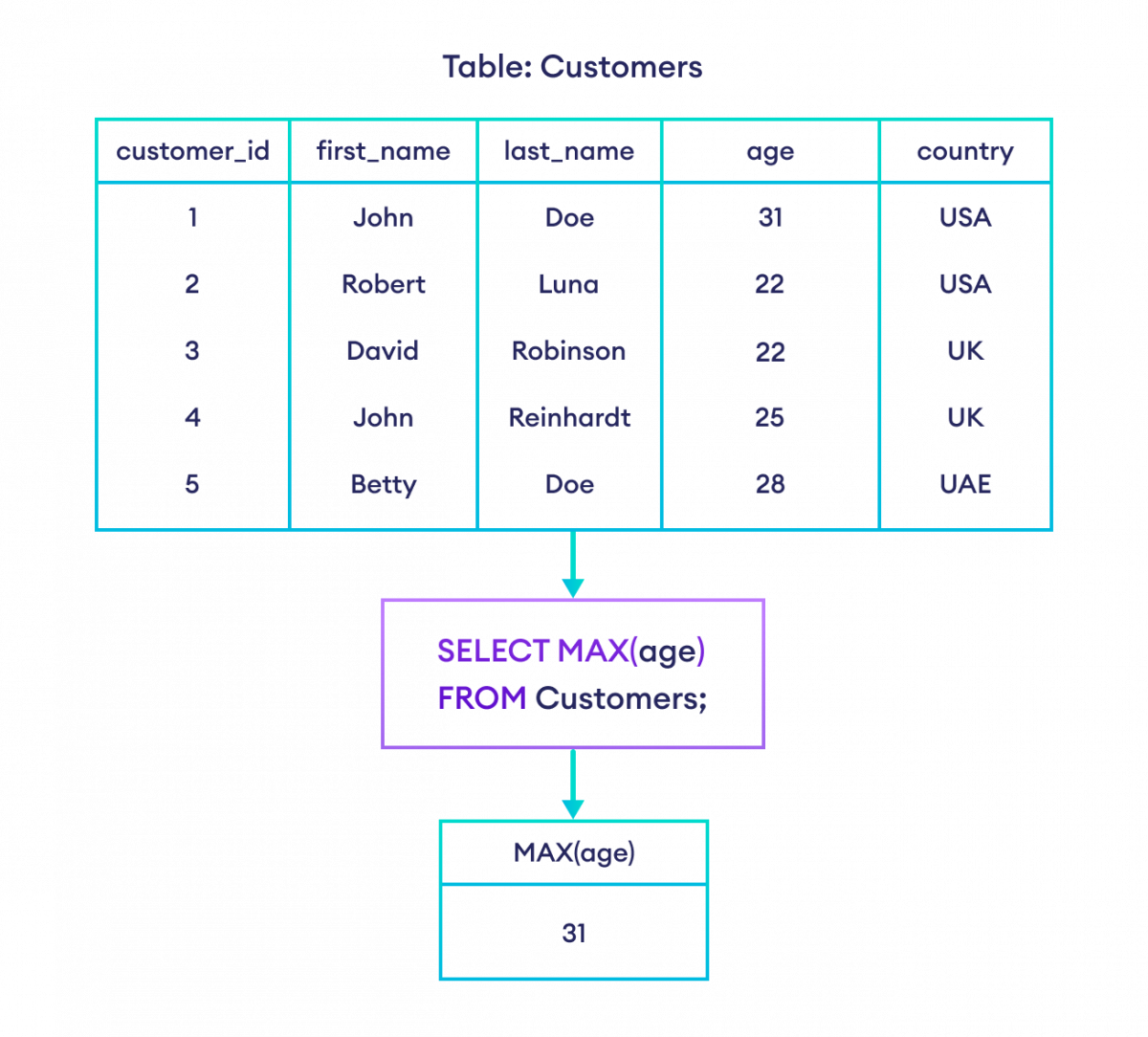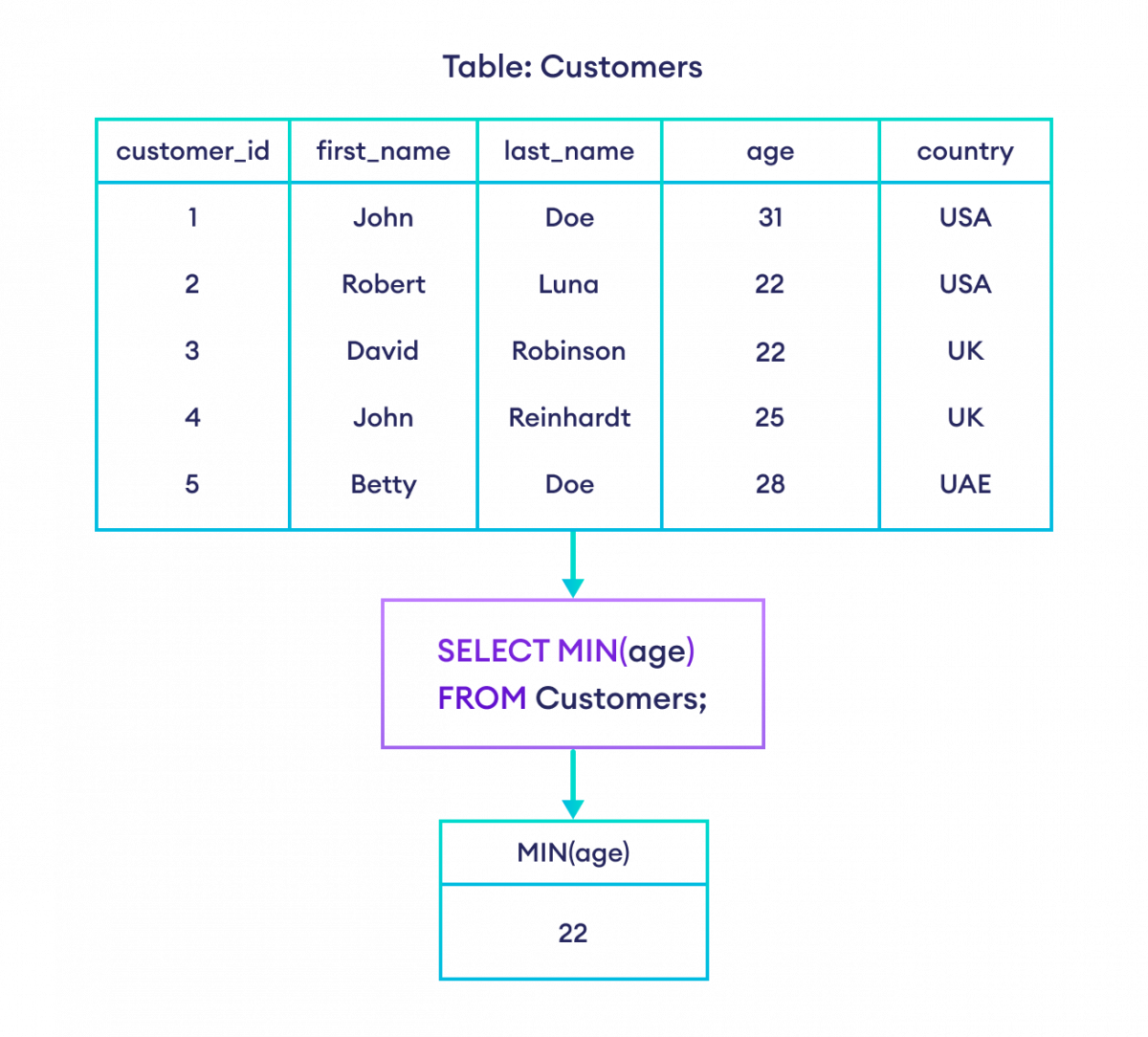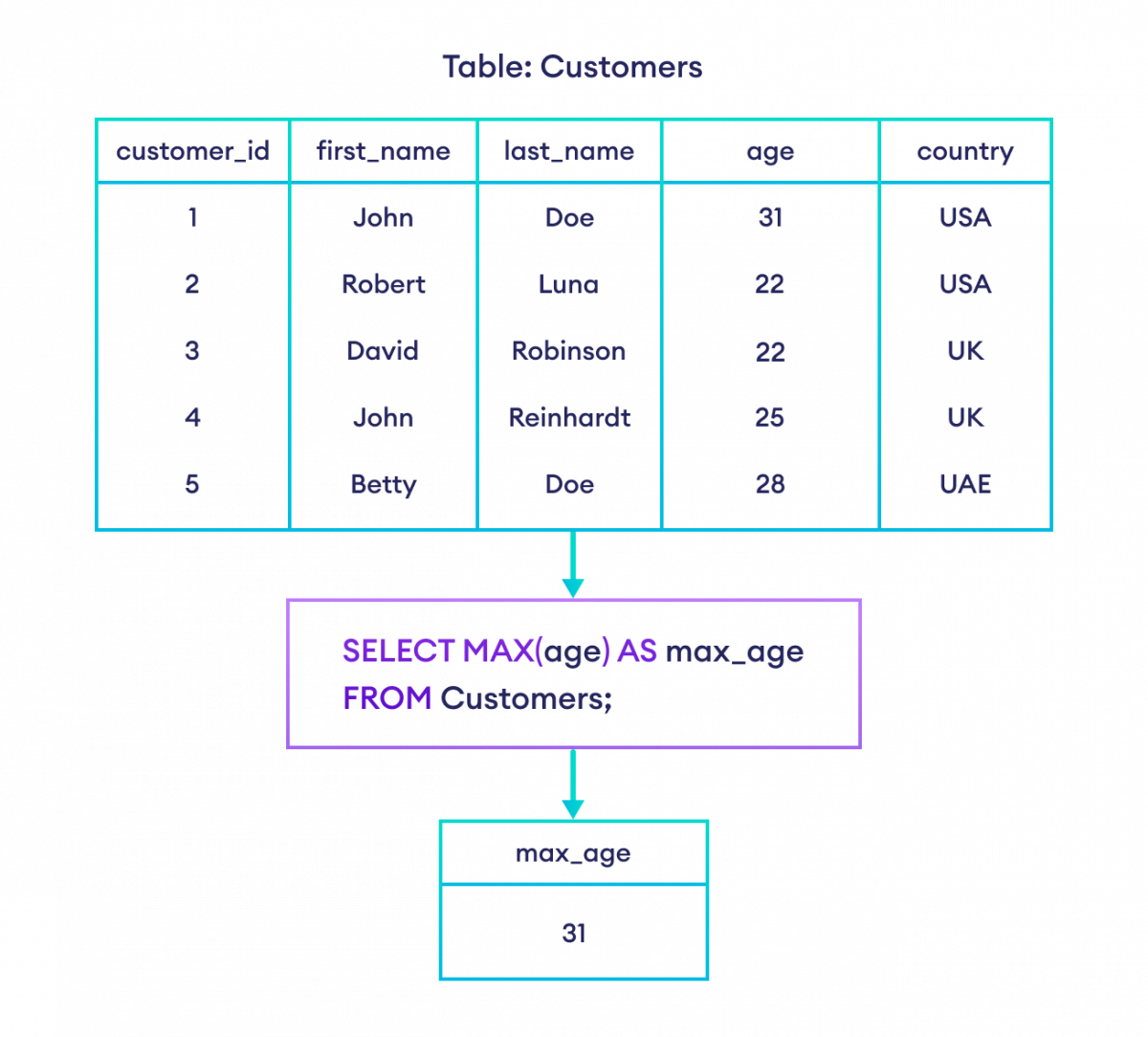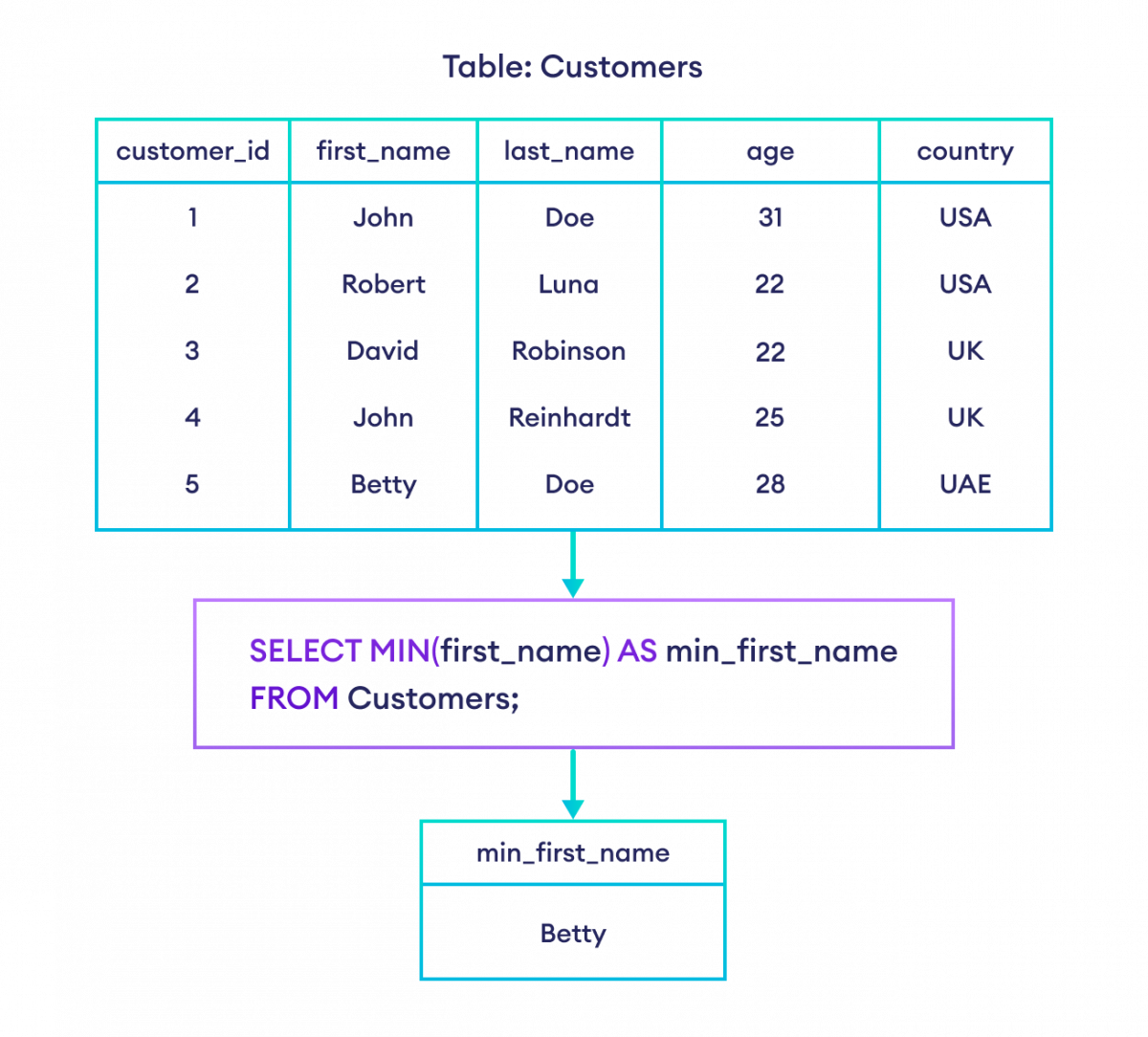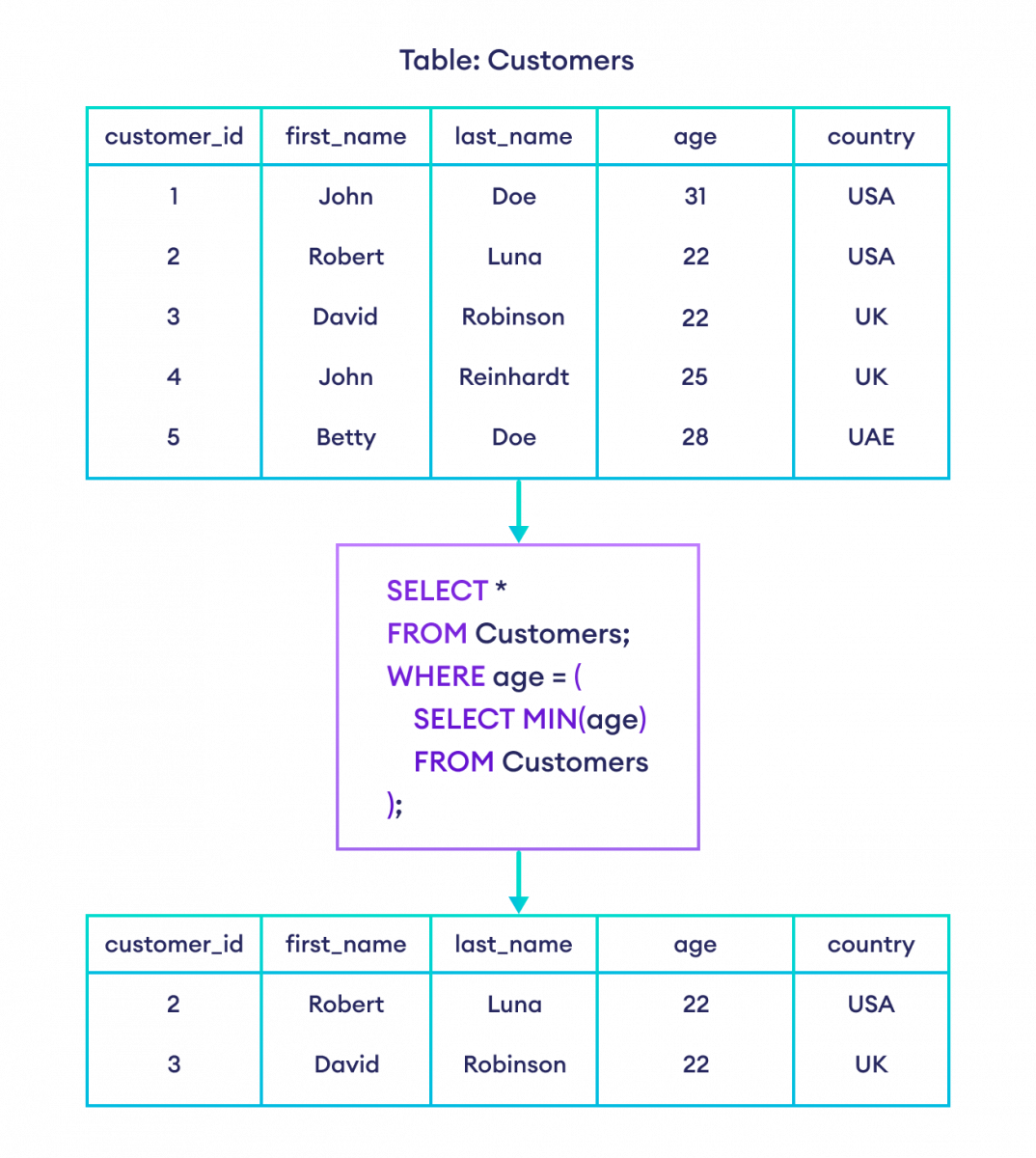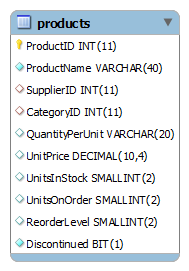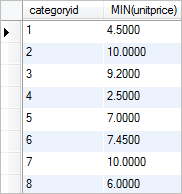Here are three examples of using SQL to find and select the row with the minimum value in a given column.
The examples work in most major RDBMSs, including MySQL, MariaDB, PostgreSQL, SQLite, Oracle, and SQL Server.
Sample Data
Let’s start with the following data:
SELECT * FROM PetShow;Result:
+---------+-----------+---------+ | PetId | PetName | Score | |---------+-----------+---------| | 1 | Wag | 85 | | 2 | Scratch | 3 | | 3 | Tweet | 65 | | 4 | Bark | 8 | | 5 | Ruff | 15 | | 6 | Woof | 20 | +---------+-----------+---------+
Option 1
Here’s our first option for selecting the row with the minimum value from the above table:
SELECT
PetId,
PetName,
Score
FROM PetShow
WHERE Score = ( SELECT MIN(Score) FROM PetShow );Result:
+---------+-----------+---------+ | PetId | PetName | Score | |---------+-----------+---------| | 2 | Scratch | 3 | +---------+-----------+---------+
Here, we used the MIN() function within a subquery to find the minimum value, and returned the whole row with the outer query.
When there are Multiple Rows with the Min Value
Using this method, if there are multiple rows with the minimum value, all of them are returned.
Suppose we insert another row into our table with the same score as the existing minimum score:
INSERT INTO PetShow VALUES (7, 'Punch', 3);
SELECT * FROM PetShow;Our table now looks like this:
+---------+-----------+---------+ | PetId | PetName | Score | |---------+-----------+---------| | 1 | Wag | 85 | | 2 | Scratch | 3 | | 3 | Tweet | 65 | | 4 | Bark | 8 | | 5 | Ruff | 15 | | 6 | Woof | 20 | | 7 | Punch | 3 | +---------+-----------+---------+
We can see that both Scratch and Punch have got the low score of 3.
Let’s run the previous query again to return the minimum value from that column:
SELECT
PetId,
PetName,
Score
FROM PetShow
WHERE Score = ( SELECT MIN(Score) FROM PetShow );Result:
+---------+-----------+---------+ | PetId | PetName | Score | |---------+-----------+---------| | 2 | Scratch | 3 | | 7 | Punch | 3 | +---------+-----------+---------+
Both rows with the minimum values are returned.
We can limit the result set to just one row if required. The exact code will depend on the RDBMS being used.
The LIMIT clause can be used with RDBSs such as PostgreSQL, MariaDB, MySQL, and SQLite:
SELECT
PetId,
PetName,
Score
FROM PetShow
WHERE Score = ( SELECT MIN(Score) FROM PetShow )
ORDER BY PetId ASC
LIMIT 1;Result:
+-------+---------+-------+ | PetId | PetName | Score | +-------+---------+-------+ | 2 | Scratch | 3 | +-------+---------+-------+
In SQL Server, we can use the TOP clause:
SELECT TOP 1
PetId,
PetName,
Score
FROM PetShow
WHERE Score = ( SELECT MIN(Score) FROM PetShow )
ORDER BY PetId ASC;Result:
+---------+-----------+---------+ | PetId | PetName | Score | |---------+-----------+---------| | 2 | Scratch | 3 | +---------+-----------+---------+
And in Oracle Database, we can do this:
SELECT
PetId,
PetName,
Score
FROM PetShow
WHERE Score = ( SELECT MIN(Score) FROM PetShow )
ORDER BY PetId ASC
FETCH FIRST 1 ROW ONLY;Result:
+---------+-----------+---------+ | PetId | PetName | Score | |---------+-----------+---------| | 2 | Scratch | 3 | +---------+-----------+---------+
Option 2
If we only want one row returned, we can actually do away with most of the other code and just get the first row out of the ordered results:
SELECT
PetId,
PetName,
Score
FROM PetShow
ORDER BY Score ASC
LIMIT 1;Result:
+-------+---------+-------+ | PetId | PetName | Score | +-------+---------+-------+ | 7 | Punch | 3 | +-------+---------+-------+
In SQL Server:
SELECT TOP 1
PetId,
PetName,
Score
FROM PetShow
ORDER BY Score ASC;Result:
+---------+-----------+---------+ | PetId | PetName | Score | |---------+-----------+---------| | 2 | Scratch | 3 | +---------+-----------+---------+
And in Oracle Database:
SELECT
PetId,
PetName,
Score
FROM PetShow
ORDER BY Score ASC
FETCH FIRST 1 ROW ONLY;Result:
+---------+-----------+---------+ | PetId | PetName | Score | |---------+-----------+---------| | 2 | Scratch | 3 | +---------+-----------+---------+
Option 3
Another way to select the row with the minimum value is to join the table on itself, like this:
SELECT
p1.PetId,
p1.PetName,
p1.Score
FROM PetShow p1
LEFT JOIN PetShow p2 ON p1.Score < p2.Score
WHERE p2.PetId IS NULL;Result:
+---------+-----------+---------+ | PetId | PetName | Score | |---------+-----------+---------| | 1 | Wag | 85 | | 8 | Purr | 85 | +---------+-----------+---------+
As with the earlier example, we can limit the results to one row (or some other number) if required.
In this tutorial, you will learn about the MAX() and MIN() functions in SQL with the help of examples.
In SQL,
- The
MAX()function returns the maximum value of a column. - The
MIN()function returns the minimum value of a column.
SQL MAX() Function
The syntax of the SQL MAX() function is:
SELECT MAX(columnn)
FROM table;Here,
columnis the name of the column you want to filtertableis the name of the table to fetch the data from
For example,
SELECT MAX(age)
FROM Customers;Here, the SQL command returns the largest value from the age column.
SQL MIN() Function
The syntax of the SQL MIN() function is:
SELECT MIN(columnn)
FROM table;Here,
columnis the name of the column you want to filtertableis the name of the table to fetch the data from
For Example,
SELECT MIN(age)
FROM Customers;Here, the SQL command returns the smallest value from the age column.
Aliases With MAX() and MIN()
In the above examples, the field names in the result sets were MIN(age) and MAX(age).
It is also possible to give custom names to these fields using the AS keyword. For example,
-- use max_age as an alias for the maximum age
SELECT MAX(age) AS max_age
FROM Customers;Here, the field name MAX(age) is replaced with max_age in the result set.
MAX() and MIN() With Strings
The MAX() and MIN() functions also work with texts. For example,
--select the minimum value of first_name from Customers
SELECT MIN(first_name) AS min_first_name
FROM Customers;Here, the SQL command selects the minimum value of first_name based on the dictionary order.
MAX() and MIN() in Nested SELECT
As we know, the MAX() function returns the maximum value. Similarly, the MIN() function returns the minimum value.
However, if we want to select the whole row containing that value, we can use the nested SELECT statement like this.
-- MIN() function in a nested SELECT statement
SELECT *
FROM Customers
WHERE age = (
SELECT MIN(age)
FROM Customers
);Here, the SQL command selects all the customers with the smallest age.
More SQL MAX() and MIN() Examples
We can also find the highest or lowest value from two or more values using the MAX() and MIN() function. For example,
-- returns 50 as highest
SELECT MAX(20, 30, 50) as highest;
-- returns 20 as lowest
SELECT MIN(20, 30, 50) as lowest;Let’s see how we can use MAX() and MIN() function with HAVING:
SELECT *
FROM Customers
GROUP BY country
HAVING MAX(age);Here, the SQL command returns the maximum age in each country from the Customers table.
To learn more, visit SQL HAVING Clause.
Recommended Readings:
- SQL Alias
- SQL Subquery (Nested Select)
Given the following table in SQL Server 2005:
ID Col1 Col2 Col3
-- ---- ---- ----
1 3 34 76
2 32 976 24
3 7 235 3
4 245 1 792
What is the best way to write the query that yields the following result (i.e. one that yields the final column — a column containing the minium values out of Col1, Col2, and Col 3 for each row)?
ID Col1 Col2 Col3 TheMin
-- ---- ---- ---- ------
1 3 34 76 3
2 32 976 24 24
3 7 235 3 3
4 245 1 792 1
UPDATE:
For clarification (as I have said in the coments) in the real scenario the database is properly normalized. These «array» columns are not in an actual table but are in a result set that is required in a report. And the new requirement is that the report also needs this MinValue column. I can’t change the underlying result set and therefore I was looking to T-SQL for a handy «get out of jail card».
I tried the CASE approach mentioned below and it works, although it is a bit cumbersome. It is also more complicated than stated in the answers because you need to cater for the fact that there are two min values in the same row.
Anyway, I thought I’d post my current solution which, given my constraints, works pretty well. It uses the UNPIVOT operator:
with cte (ID, Col1, Col2, Col3)
as
(
select ID, Col1, Col2, Col3
from TestTable
)
select cte.ID, Col1, Col2, Col3, TheMin from cte
join
(
select
ID, min(Amount) as TheMin
from
cte
UNPIVOT (Amount for AmountCol in (Col1, Col2, Col3)) as unpvt
group by ID
) as minValues
on cte.ID = minValues.ID
I’ll say upfront that I don’t expect this to offer the best performance, but given the circumstances (I can’t redesign all the queries just for the new MinValue column requirement), it is a pretty elegant «get out of jail card».
Salman A
259k82 gold badges428 silver badges520 bronze badges
asked Dec 15, 2008 at 13:27
2
There are likely to be many ways to accomplish this. My suggestion is to use Case/When to do it. With 3 columns, it’s not too bad.
Select Id,
Case When Col1 < Col2 And Col1 < Col3 Then Col1
When Col2 < Col1 And Col2 < Col3 Then Col2
Else Col3
End As TheMin
From YourTableNameHere
answered Dec 15, 2008 at 13:39
George MastrosGeorge Mastros
24k4 gold badges50 silver badges59 bronze badges
7
Using CROSS APPLY:
SELECT ID, Col1, Col2, Col3, MinValue
FROM YourTable
CROSS APPLY (SELECT MIN(d) AS MinValue FROM (VALUES (Col1), (Col2), (Col3)) AS a(d)) A
SQL Fiddle
answered Apr 23, 2015 at 21:35
NizamNizam
4,5393 gold badges41 silver badges60 bronze badges
8
SELECT ID, Col1, Col2, Col3,
(SELECT MIN(Col) FROM (VALUES (Col1), (Col2), (Col3)) AS X(Col)) AS TheMin
FROM Table
The OP was tagged as sql-server, and this is an SQL Server specific answer. May not work on other DBMSs. (Search for least for Postgres derived DBs and some others).
answered Jan 4, 2016 at 11:03
dszdsz
4,39538 silver badges32 bronze badges
5
On MySQL, use this:
select least(col1, col2, col3) FROM yourtable
HappyTown
5,8967 gold badges36 silver badges51 bronze badges
answered Apr 3, 2014 at 9:46
user3493139user3493139
3973 silver badges3 bronze badges
9
You can use the «brute force» approach with a twist:
SELECT CASE
WHEN Col1 <= Col2 AND Col1 <= Col3 THEN Col1
WHEN Col2 <= Col3 THEN Col2
ELSE Col3
END AS [Min Value] FROM [Your Table]
When the first when condition fails it guarantees that Col1 is not the smallest value therefore you can eliminate it from rest of the conditions. Likewise for subsequent conditions. For five columns your query becomes:
SELECT CASE
WHEN Col1 <= Col2 AND Col1 <= Col3 AND Col1 <= Col4 AND Col1 <= Col5 THEN Col1
WHEN Col2 <= Col3 AND Col2 <= Col4 AND Col2 <= Col5 THEN Col2
WHEN Col3 <= Col4 AND Col3 <= Col5 THEN Col3
WHEN Col4 <= Col5 THEN Col4
ELSE Col5
END AS [Min Value] FROM [Your Table]
Note that if there is a tie between two or more columns then <= ensures that we exit the CASE statement as early as possible.
answered Mar 2, 2015 at 13:09
Salman ASalman A
259k82 gold badges428 silver badges520 bronze badges
1
If the columns were integers as in your example I would create a function:
create function f_min_int(@a as int, @b as int)
returns int
as
begin
return case when @a < @b then @a else coalesce(@b,@a) end
end
then when I need to use it I would do :
select col1, col2, col3, dbo.f_min_int(dbo.f_min_int(col1,col2),col3)
if you have 5 colums then the above becomes
select col1, col2, col3, col4, col5,
dbo.f_min_int(dbo.f_min_int(dbo.f_min_int(dbo.f_min_int(col1,col2),col3),col4),col5)
answered Aug 28, 2012 at 13:48
GeorgiosGeorgios
691 silver badge2 bronze badges
2
The best way to do that is probably not to do it — it’s strange that people insist on storing their data in a way that requires SQL «gymnastics» to extract meaningful information, when there are far easier ways to achieve the desired result if you just structure your schema a little better 
The right way to do this, in my opinion, is to have the following table:
ID Col Val
-- --- ---
1 1 3
1 2 34
1 3 76
2 1 32
2 2 976
2 3 24
3 1 7
3 2 235
3 3 3
4 1 245
4 2 1
4 3 792
with ID/Col as the primary key (and possibly Col as an extra key, depending on your needs). Then your query becomes a simple select min(val) from tbl and you can still treat the individual ‘old columns’ separately by using where col = 2 in your other queries. This also allows for easy expansion should the number of ‘old columns’ grow.
This makes your queries so much easier. The general guideline I tend to use is, if you ever have something that looks like an array in a database row, you’re probably doing something wrong and should think about restructuring the data.
However, if for some reason you can’t change those columns, I’d suggest using insert and update triggers and add another column which these triggers set to the minimum on Col1/2/3. This will move the ‘cost’ of the operation away from the select to the update/insert where it belongs — most database tables in my experience are read far more often than written so incurring the cost on write tends to be more efficient over time.
In other words, the minimum for a row only changes when one of the other columns change, so that’s when you should be calculating it, not every time you select (which is wasted if the data isn’t changing). You would then end up with a table like:
ID Col1 Col2 Col3 MinVal
-- ---- ---- ---- ------
1 3 34 76 3
2 32 976 24 24
3 7 235 3 3
4 245 1 792 1
Any other option that has to make decisions at select time is usually a bad idea performance-wise, since the data only changes on insert/update — the addition of another column takes up more space in the DB and will be slightly slower for the inserts and updates but can be much faster for selects — the preferred approach should depend on your priorities there but, as stated, most tables are read far more often than they’re written.
answered Dec 15, 2008 at 13:43
paxdiablopaxdiablo
847k233 gold badges1568 silver badges1943 bronze badges
6
You could also do this with a union query. As the number of columns increase, you would need to modify the query, but at least it would be a straight forward modification.
Select T.Id, T.Col1, T.Col2, T.Col3, A.TheMin
From YourTable T
Inner Join (
Select A.Id, Min(A.Col1) As TheMin
From (
Select Id, Col1
From YourTable
Union All
Select Id, Col2
From YourTable
Union All
Select Id, Col3
From YourTable
) As A
Group By A.Id
) As A
On T.Id = A.Id
answered Dec 15, 2008 at 13:51
George MastrosGeorge Mastros
24k4 gold badges50 silver badges59 bronze badges
2
This is brute force but works
select case when col1 <= col2 and col1 <= col3 then col1
case when col2 <= col1 and col2 <= col3 then col2
case when col3 <= col1 and col3 <= col2 then col3
as 'TheMin'
end
from Table T
… because min() works only on one column and not across columns.
answered Dec 15, 2008 at 13:40
LearningLearning
7,9793 gold badges35 silver badges46 bronze badges
1
Both this question
And this question try to answer this.
The recap is that Oracle has a built in function for this, with Sql Server you are stuck either defining a user-defined-function or using case statements.
answered Dec 16, 2008 at 2:40
Sam SaffronSam Saffron
128k78 gold badges326 silver badges505 bronze badges
For multiple columns its best to use a CASE statement, however for two numeric columns i and j you can use simple math:
min(i,j) = (i+j)/2 — abs(i-j)/2
This formula can be used to get the minimum value of multiple columns but its really messy past 2, min(i,j,k) would be min(i,min(j,k))
answered Oct 11, 2016 at 15:50
crowleycrowley
1001 silver badge5 bronze badges
If you’re able to make a stored procedure, it could take an array of values, and you could just call that.
answered Dec 15, 2008 at 13:44
KevKev
15.7k15 gold badges79 silver badges112 bronze badges
4
select *,
case when column1 < columnl2 And column1 < column3 then column1
when columnl2 < column1 And columnl2 < column3 then columnl2
else column3
end As minValue
from tbl_example
answered Dec 15, 2008 at 13:46
1
A little twist on the union query:
DECLARE @Foo TABLE (ID INT, Col1 INT, Col2 INT, Col3 INT)
INSERT @Foo (ID, Col1, Col2, Col3)
VALUES
(1, 3, 34, 76),
(2, 32, 976, 24),
(3, 7, 235, 3),
(4, 245, 1, 792)
SELECT
ID,
Col1,
Col2,
Col3,
(
SELECT MIN(T.Col)
FROM
(
SELECT Foo.Col1 AS Col UNION ALL
SELECT Foo.Col2 AS Col UNION ALL
SELECT Foo.Col3 AS Col
) AS T
) AS TheMin
FROM
@Foo AS Foo
answered Aug 30, 2011 at 20:53
If you use SQL 2005 you can do something neat like this:
;WITH res
AS ( SELECT t.YourID ,
CAST(( SELECT Col1 AS c01 ,
Col2 AS c02 ,
Col3 AS c03 ,
Col4 AS c04 ,
Col5 AS c05
FROM YourTable AS cols
WHERE YourID = t.YourID
FOR
XML AUTO ,
ELEMENTS
) AS XML) AS colslist
FROM YourTable AS t
)
SELECT YourID ,
colslist.query('for $c in //cols return min(data($c/*))').value('.',
'real') AS YourMin ,
colslist.query('for $c in //cols return avg(data($c/*))').value('.',
'real') AS YourAvg ,
colslist.query('for $c in //cols return max(data($c/*))').value('.',
'real') AS YourMax
FROM res
This way you don’t get lost in so many operators 
However, this could be slower than the other choice.
It’s your choice…
SteveC
15.6k23 gold badges101 silver badges173 bronze badges
answered Dec 15, 2008 at 15:53
leoinfoleoinfo
7,8408 gold badges36 silver badges48 bronze badges
2
If you know what values you are looking for, usually a status code, the following can be helpful:
select case when 0 in (PAGE1STATUS ,PAGE2STATUS ,PAGE3STATUS,
PAGE4STATUS,PAGE5STATUS ,PAGE6STATUS) then 0 else 1 end
FROM CUSTOMERS_FORMS
answered Aug 28, 2013 at 19:47
Israel MarguliesIsrael Margulies
8,6062 gold badges30 silver badges26 bronze badges
Below I use a temp table to get the minimum of several dates. The first temp table queries several joined tables to get various dates (as well as other values for the query), the second temp table then gets the various columns and the minimum date using as many passes as there are date columns.
This is essentially like the union query, the same number of passes are required, but may be more efficient (based on experience, but would need testing). Efficiency wasn’t an issue in this case (8,000 records). One could index etc.
--==================== this gets minimums and global min
if object_id('tempdb..#temp1') is not null
drop table #temp1
if object_id('tempdb..#temp2') is not null
drop table #temp2
select r.recordid , r.ReferenceNumber, i.InventionTitle, RecordDate, i.ReceivedDate
, min(fi.uploaddate) [Min File Upload], min(fi.CorrespondenceDate) [Min File Correspondence]
into #temp1
from record r
join Invention i on i.inventionid = r.recordid
left join LnkRecordFile lrf on lrf.recordid = r.recordid
left join fileinformation fi on fi.fileid = lrf.fileid
where r.recorddate > '2015-05-26'
group by r.recordid, recorddate, i.ReceivedDate,
r.ReferenceNumber, i.InventionTitle
select recordid, recorddate [min date]
into #temp2
from #temp1
update #temp2
set [min date] = ReceivedDate
from #temp1 t1 join #temp2 t2 on t1.recordid = t2.recordid
where t1.ReceivedDate < [min date] and t1.ReceivedDate > '2001-01-01'
update #temp2
set [min date] = t1.[Min File Upload]
from #temp1 t1 join #temp2 t2 on t1.recordid = t2.recordid
where t1.[Min File Upload] < [min date] and t1.[Min File Upload] > '2001-01-01'
update #temp2
set [min date] = t1.[Min File Correspondence]
from #temp1 t1 join #temp2 t2 on t1.recordid = t2.recordid
where t1.[Min File Correspondence] < [min date] and t1.[Min File Correspondence] > '2001-01-01'
select t1.*, t2.[min date] [LOWEST DATE]
from #temp1 t1 join #temp2 t2 on t1.recordid = t2.recordid
order by t1.recordid
answered Jan 2, 2016 at 0:37
SELECT [ID],
(
SELECT MIN([value].[MinValue])
FROM
(
VALUES
([Col1]),
([Col1]),
([Col2]),
([Col3])
) AS [value] ([MinValue])
) AS [MinValue]
FROM Table;
answered Nov 10, 2017 at 10:11
I know that question is old, but I was still in the need of the answer and was not happy with other answers so I had to devise my own which is a twist on @paxdiablo´s answer.
I came from land of SAP ASE 16.0, and I only needed a peek at statistics of certain data which are IMHO validly stored in different columns of a single row (they represent different times — when arrival of something was planned, what it was expected when the action started and finally what was the actual time). Thus I had transposed columns into the rows of temporary table and preformed my query over this as usually.
N.B. Not the one-size-fits-all solution ahead!
CREATE TABLE #tempTable (ID int, columnName varchar(20), dataValue int)
INSERT INTO #tempTable
SELECT ID, 'Col1', Col1
FROM sourceTable
WHERE Col1 IS NOT NULL
INSERT INTO #tempTable
SELECT ID, 'Col2', Col2
FROM sourceTable
WHERE Col2 IS NOT NULL
INSERT INTO #tempTable
SELECT ID, 'Col3', Col3
FROM sourceTable
WHERE Col3 IS NOT NULL
SELECT ID
, min(dataValue) AS 'Min'
, max(dataValue) AS 'Max'
, max(dataValue) - min(dataValue) AS 'Diff'
FROM #tempTable
GROUP BY ID
This took some 30 seconds on source set of 630000 rows and used only index-data, so not the thing to run in time-critical process but for things like one-time data inspection or end-of-the-day report you might be fine (but verify this with your peers or superiors, please!).
Main bonus of this style for me was that I could readily use more/less columns and change grouping, filtering, etc., especially once data was copyied over.
The additional data (columnName, maxes, …) were to aid me in my search, so you might not need them; I left them here to maybe spark some ideas :-).
answered Apr 18, 2019 at 13:25
RaoRao
7827 silver badges17 bronze badges
case
when Col1 < Col2 and Col1 < Col3
then Col1
when Col2 is null and Col3 is null
then Col1
when Col1 < Col2 and Col3 is null
then Col1
when Col1 < Col3 and Col2 is null
then Col1
when Col2 < Col1 and Col2 < Col3
then Col2
when Col1 is null and Col3 is null
then Col2
when Col2 < Col1 and Col3 is null
then Col2
when Col2 < Col3 and Col1 is null
then Col2
when Col3 < Col1 and Col3 < Col2
then Col3
when Col1 is null and Col2 is null
then Col3
when Col3 < Col1 and Col2 is null
then Col3
when Col3 < Col2 and Col1 is null
then Col3
when Col2 = Col3
then Col2
when Col1 = Col3
then Col1
when Col1 = Col2
then Col1
when Col2 = Col3 and Col1 = Col3
then Col1
else null end as ‘MIN’
answered Jul 19, 2021 at 23:43
EmilyEmily
91 bronze badge
1
В этом учебном материале вы узнаете, как использовать SQL функцию MIN с синтаксисом и примерами.
Описание
SQL функция MIN используется для возврата минимального значения выражения в операторе SELECT.
Синтаксис
Синтаксис для функции MIN в SQL.
SELECT MIN(aggregate_expression)
FROM tables
[WHERE conditions];
Или синтаксис для функции MIN при группировке результатов по одному или нескольким столбцам.
SELECT expression1, expression2, … expression_n,
MIN(aggregate_expression)
FROM tables
[WHERE conditions]
GROUP BY expression1, expression2, … expression_n;
Параметры или аргумент
- expression1, expression2, … expression_n
- Выражения, которые не инкапсулированы в функции MIN и должны быть включены в предложение GROUP BY в конце SQL запроса
- aggregate_expression
- Это столбец или выражение, из которого будет возвращено минимальное значение
- tables
- Таблицы, из которых вы хотите получить записи. В предложении FROM должна быть указана хотя бы одна таблица
- WHERE conditions
- Необязательный. Это условия, которые должны быть выполнены для выбора записей
Пример — с одним выражением
Простейшим способом использования SQL функции MIN было бы возвращение одного поля, которое вычисляет значение MIN.
Например, вы можете узнать минимальную зарплату всех сотрудников.
|
SELECT MIN(salary) AS «Lowest salary» FROM employees; |
В этом примере SQL функции MIN у нас выражению MIN(salary) указан псевдоним «Lowest salary». В результате «Lowest salary» будет отображаться как имя поля при возврате набора результатов.
Пример — использование SQL GROUP BY
В некоторых случаях вам потребуется использовать SQL оператор GROUP BY с функцией MIN.
Например, вы также можете использовать SQL функцию MIN, чтобы вернуть название каждого отдела и минимальную зарплату в отделе.
|
SELECT department, MIN(salary) AS «Lowest salary» FROM employees GROUP BY department; |
Поскольку в SQL операторе SELECT указан один столбец, который не инкапсулирован в SQL функцию MIN, необходимо использовать SQL оператор GROUP BY. Поэтому поле department должно быть указано в разделе GROUP BY.
Summary: in this tutorial, you will learn how to use the SQL MIN function to get the minimum value in a set.
Introduction to SQL MIN function
The MIN function returns the minimum value in a set of values. The MIN function ignores the NULL values. The following is the syntax of the MIN function:
MIN(DISTINCT or ALL expression)
The ALL modifier instructs the MIN function to find the minimum value in all values including duplicates. The MIN() function uses the ALL modifier by default so you don’t have to specify it explicitly.
Unlike other aggregate functions e.g., SUM, COUNT, and AVG, the DISTINCT modifier is not applicable to the MIN() function. The DISTINCT modifier is only for ISO compatibility.
SQL MIN function examples
Let’s take a look at the products table in the sample database:
Simple MIN function example
To find the lowest unit price of products in the products table, you use the MIN() function as follows:
SELECT MIN(unitprice) FROM products;
To get the cheapest products, you have to use a subquery that uses the MIN() function as the following query:
SELECT productid, productname, unitprice FROM products WHERE unitprice = ( SELECT MIN(unitprice) FROM products);
The outer query gets the cheapest products whose unit prices match the lowest price returned by the subquery. If multiple products have the same unit price as the lowest price, the query will return more than one row.
SQL MIN function with GROUP BY clause example
To find the lowest unit price of the product in each category, you use the MIN() function with a GROUP BY clause:
SELECT categoryid, MIN(unitprice) FROM products GROUP BY categoryid;
The GROUP BY clause divides the products by categoryid into groups. For each group, the MIN() function returns the lowest unit price.
SQL MIN function with HAVING clause example
To get the category that has the lowest unit price less than $7, you use the MIN() function with the GROUP BY and HAVING clauses as follows:
SELECT categoryid, MIN(unitprice) FROM products GROUP BY categoryid HAVING MIN(unitprice) < 7;
SQL MIN with correlated subquery example
To get the cheapest product in each category, you use the MIN() function in a correlated subquery as follows:
SELECT categoryid, productid, productName, unitprice FROM products a WHERE unitprice = ( SELECT MIN(unitprice) FROM products b WHERE b.categoryid = a.categoryid)
The outer query scans all rows in the products table and returns the products that have unit prices match the lowest price in each category returned by the correlated subquery.
In this tutorial, we have shown you how to use SQL MIN function to get the minimum value in a set.

